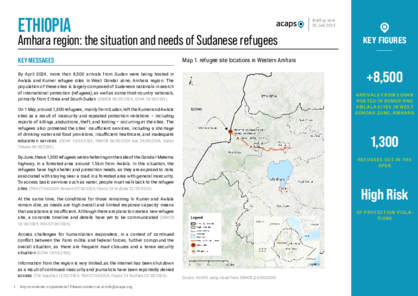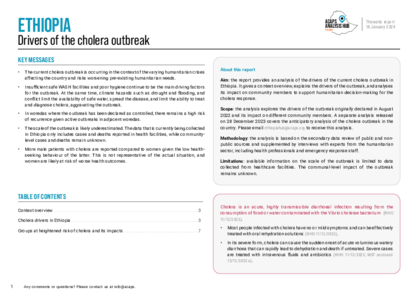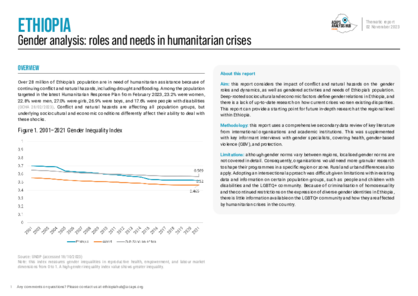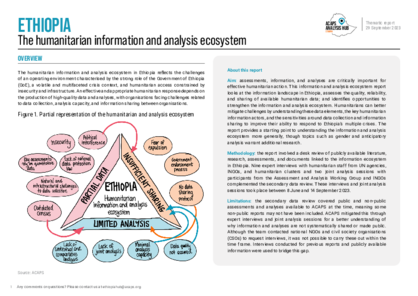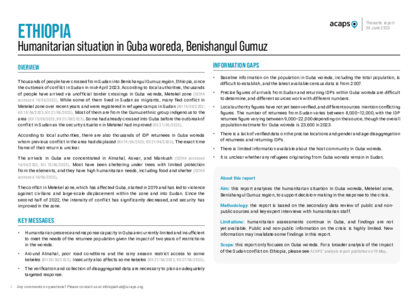Latest updates on country situation
29 July 2024
Until 30 July 2024, heavy rains on 21–22 July in Gezei Gofa woreda of Gofa zone, South Ethiopia region, caused three successive landslides that killed nearly 260 people, affected over 15,000, and displaced at least 600. Some of the displaced are sheltering with host communities, while others are planned to be taken to temporary shelters in relocation areas. Those still in the woreda are at high risk of experiencing further landslides and need to be evacuated to safe zones. They include at least 1,300 children under five and over 5,000 pregnant and lactating women, more than 400 of whom are in critical need of nutrition support. Heavy rains and difficult terrain challenge access to the affected areas. The affected people need shelter, food, nutrition, WASH, health services, and NFIs. (WHO 30/07/2024, OCHA 26/07/2024)
21 May 2024
The heavy rains and flooding in Ethiopia in April and early May have affected numerous regions. Up until 17 May, over 560,000 people have been impacted, with over 57,000 displaced. The affected regions include Afar, Amhara, Central Ethiopia, Oromia, Sidama, Somali, South Ethiopia, South West Ethiopia People’s, Tigray regions, and Dire Dawa City Administration. Livelihoods have been disrupted, with cropland and livestock lost, worsening food insecurity for pastoralist and agropastoralist communities. Humanitarian access has been limited because of damaged road infrastructure. Houses, including tents in displacement sites, have been damaged, forcing IDPs to share tents in congested conditions and posing health and protection challenges. Current rapid response capacities in the country are very limited because of conflict and climate-related shocks such as drought. The affected populations urgently require food, shelter, NFIs, protection, and WASH services. (ECHO 16/05/2024, OCHA 21/05/2024)
15 March 2024
In 2023, one in two refugee children aged between 6–59 months in Ethiopia was undernourished. Multiple major shocks deteriorated the country's food security in 2023. If funding remains insufficient, there is an increased risk of mortality from acute malnutrition for over 86,675 refugee children under five years.
(UNHCR 14/03/2024)
18 December 2023
In December 2023, El Niño-induced floods affected around 1.5 million people in various regions of Ethiopia, including Afar, Amhara, Gambela, Oromia, Somali, South Ethiopia region, and South West Ethiopia region. As at 6 December, the floods had displaced over 616,000 people and led to at least 60 fatalities. Many of the displaced have moved to public buildings, such as schools, many of which have been damaged. Other damaged infrastructure includes houses and health facilities. The floods have also resulted in damage to croplands and livestock deaths, significantly affecting people’s livelihoods. Affected people need shelter, food, NFIs, WASH, health, and cash assistance. The Deyr rainy season typically runs from October–December. More rainfall is forecast in South Ethiopia Region, which could worsen the impact of the floods. (OCHA 18/12/2023, Shelter Cluster 12/12/2023)
07 November 2023
Since early November, heavy rainfall in southern and eastern Ethiopia has caused flooding in the Somali Region. As at 7 November, around 20 people have died and more than 12,000 people have been displaced. Livelihoods have been destroyed and critical infrastructure damaged hampering the delivery of aid to those affected.
26 September 2023
As at 16 September 2023, more than 81,000 forcibly displaced people from Sudan had arrived in Amhara, Benishangul Gumuz, and Gambela regions of Ethiopia. The majority were Ethiopian returnees requiring onward transportation. More than 20,000 Sudanese refugees require food, WASH, health, and protection services. Heavy rains are constraining access. (IOM 21/09/2023, UNHCR 15/09/2023)
29 August 2023
As at 29 August 2023, clashes that started in July between regional special forces, including militia allies called Fano, and the Ethiopian National Defense Force had killed at least 183 people in Amhara. Humanitarian access constraints worsen the situation. These constraints include blocked internet access, the on-and-off suspension of flights to conflict-affected areas, and the state of emergency. The exact humanitarian needs are unclear but likely involve protection services, shelter, food, health, and WASH services.
(OHCHR 29/08/2023, AI 18/08/2023, OCHA 22/08/2023)
current crises
in
Ethiopia
These crises have been identified through the INFORM Severity Index, a tool for measuring and comparing the severity of humanitarian crises globally.
ETH005 - Drought
Last updated 26/12/2024
Drivers
Drought
Crisis level
Country
Severity level
4.1 Very High
Access constraints
2.0
REG014 - Eastern Africa Regional Drought Crisis
Last updated 28/10/2024
Drivers
Drought
Crisis level
Regional
Severity level
4.4 Very High
Access constraints
5.0
ETH004 - Northern Ethiopia Conflict
Last updated 26/12/2024
Drivers
Conflict
Displacement
Crisis level
Country
Severity level
4.2 Very High
Access constraints
4.0
ETH001 - Complex crisis
Last updated 26/12/2024
Drivers
Displacement
Floods
Conflict
Crisis level
Country
Severity level
4.3 Very High
Access constraints
4.0
ETH003 - International Displacement
Last updated 26/12/2024
Drivers
Displacement
Crisis level
Country
Severity level
3 Medium
Access constraints
4.0
Analysis products
on
Ethiopia
05 July 2024
Ethiopia: situation and needs of Sudanese refugees in Amhara region
DOCUMENT / PDF / 529 KB
This report analyses the humanitarian needs of Sudanese refugees hosted at the Kumer and Awlala refugee camps, those who left and are sheltering outside, and the factors aggravating the situation in order to support humanitarian decision-making.
Attached resources
18 January 2024
Ethiopia: drivers of the cholera outbreak
DOCUMENT / PDF / 1 MB
The report provides an analysis of the drivers of the current cholera outbreak in Ethiopia. It gives a context overview, explains the drivers of the outbreak, and analyses its impact on community members to support humanitarian decision-making for the cholera response.
02 November 2023
Ethiopia: gender analysis on roles and needs in humanitarian crises
DOCUMENT / PDF / 576 KB
This report considers the impact of conflict and natural hazards on the gender roles and dynamics, as well as gendered activities and needs of Ethiopia’s population. Deep-rooted sociocultural and economic factors define gender relations in Ethiopia, and there is a lack of up-to-date research on how current crises worsen existing disparities. This report can provide a starting point for future in-depth research at the regional level within Ethiopia.
29 September 2023
Ethiopia: the humanitarian information and analysis ecosystem
DOCUMENT / PDF / 1 MB
This information and analysis ecosystem report looks at the information landscape in Ethiopia, assesses the quality, reliability, and sharing of available humanitarian data; and identifies opportunities to strengthen the information and analysis ecosystem. The report provides a starting point to understanding the information and analysis ecosystem more generally, though topics such as gender and anticipatory analysis warrant additional research.


